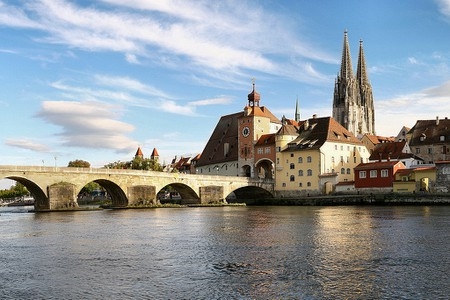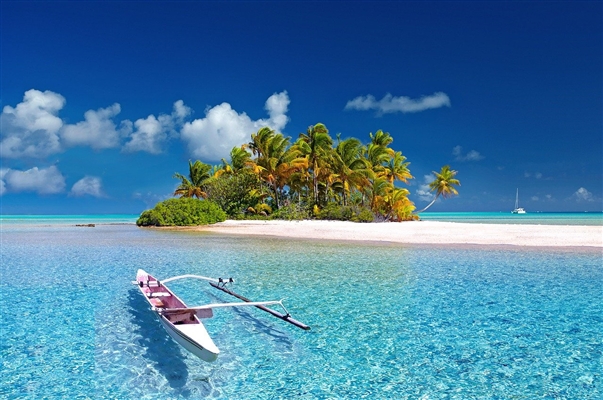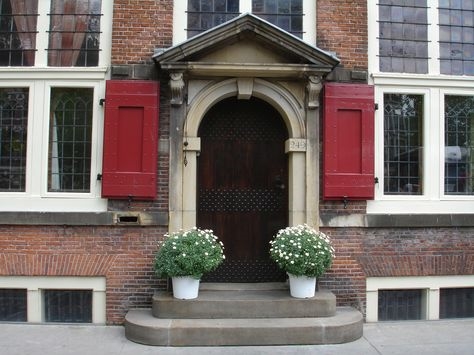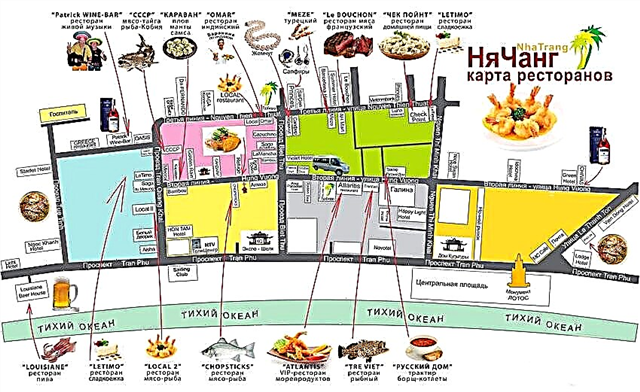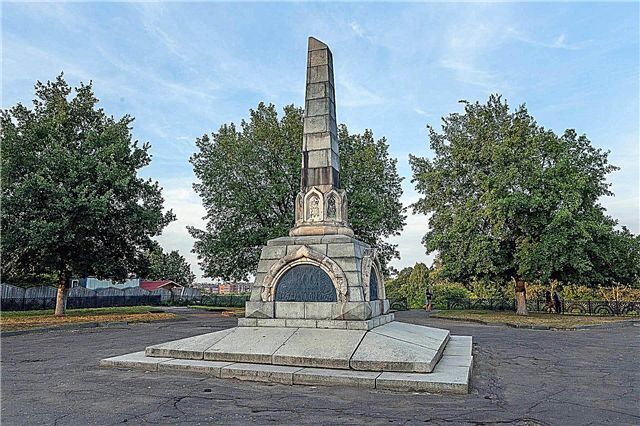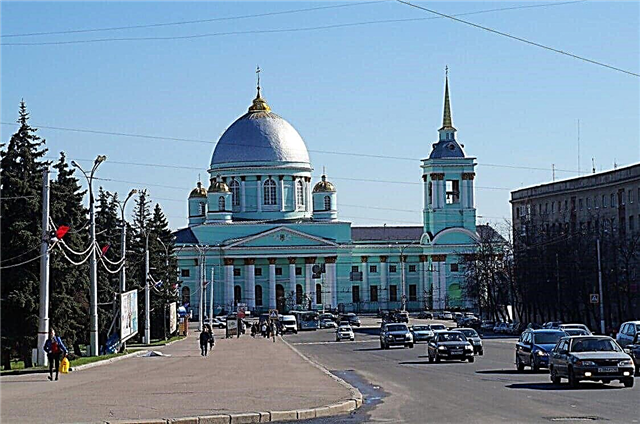Kursk region is an ancient picturesque land with a 1000-year history. Today it has a well-developed infrastructure and offers a wide variety of tourist routes. The history of the region is firmly connected with the Great Patriotic War. Numerous monuments and memorial complexes are dedicated to its key battle - the Battle of Kursk. The region is famous for its ancient monasteries and Orthodox churches. Its main shrine - the Kursk Root Icon of the Mother of God - is known far beyond the borders of the country.
The Kursk magnetic anomaly passes through the region. Anyone can visit the Mikhailovsky GOK and see the ore mining process from the observation deck. And the Kursk land is the well-known nightingale land of Russia. Connoisseurs and nature lovers come specially to listen and record the trills of vociferous singers.
The most interesting and beautiful places in the region
List, photos with names and descriptions of the sights of the Kursk region!
Indigenous desert
The men's monastery 30 km from the regional center, in the village of Svoboda, is one of the main religious centers of Russia. It was erected on the site of the discovery of the icon of the Mother of God "The Sign" in the 13th century. Thousands of pilgrims come today to worship this miraculous shrine, as well as swim in life-giving springs, enjoy the picturesque surrounding views. In Soviet times, most of the monastery buildings were destroyed, restoration continues to this day.

Memorial complex "Kursk Bulge"
The creation of a large memorial in honor of the defeat of the Germans in the Battle of the Kursk Bulge was timed to coincide with the 55th anniversary of the Great Victory. On the alley along Pobeda Avenue, there is a 24-meter Triumphal Arch with a statue of St. George the Victorious, the Tomb of the Unknown Soldier, a three-tiered church with the names of fallen soldiers carved in it, a monument to G. Zhukov, and a monument to the fallen Kurds. And also samples of military equipment used in the battle are presented.

Estate of Maryino
The family estate of the princes Baryatinsky in the village of Maryino amazes with its grandeur, luxury and rich interior decoration even today. The estate was built at the beginning of the 19th century. In the center is a three-storey palace with wings and white-stone staircases. The decorative finishing of all rooms, wall paintings, stucco moldings, chandeliers, and parquet from valuable tree species have been preserved. The palace is surrounded by a landscape park with ponds. Today it houses the presidential sanatorium.

Streletskaya steppe
This is the name of the Kursk Biosphere Reserve, which bears the name of its founder, Professor Alekhine. Most of the protected area is occupied by virgin steppes with varied, lush blooming vegetation, a slightly smaller part is covered with forests. The reserve consists of six sites located at a distance from each other. A special attraction of the Streletskaya steppe is a 1000-year-old statue of a Polovtsian warrior, called a "stone woman".

Kursk magnetic anomaly
In the depths of the Kursk Magnetic Anomaly, with an area of 160 thousand km2, half of all iron ore reserves on the planet are mined. The Mikhailovskoye deposit in the Zheleznogorsk region began to be developed in the second half of the 20th century. The depth of the quarry is 380 m, the mined rock is transported upstairs by huge dump trucks and platforms by rail. The whole process can be observed from the observation deck. Further, the ore is transported to a nearby processing plant.

Kursk Znamensky Bogoroditsky Monastery
The founding date of one of the oldest monasteries in the Kursk Territory is considered to be 1613. It was built at the direction of Mikhail Romanov, who had just ascended the throne then. For three centuries, one of the most revered shrines was kept within the walls of the monastery - the miraculous Root Icon of the Mother of God. Every year a religious procession was performed from here with the transfer of the icon to the Root Hermitage. Since 1924, the monastery was abolished and dilapidated. The restoration began at the end of the last century.

Nicholas Monastery Rylsk
The first mention of the monastery dates back to the beginning of the 16th century. At first, all of its buildings were made of wood, later, during the 18th century, they were replaced by stone ones. The territory of the monastery included 4 churches, a bell tower, a refectory, buildings for abbots and brothers, a religious school. Since 1925, the monastery was abolished and plundered. The return of his church took place in the early 90s, renovation work began, and services resumed.

House-Museum of Afanasy Fet in Vorobyovka
At his estate in the village of Vorobyovka, on the banks of the Tuskar River, Afanasy Fet spent the last 15 years of his life, only occasionally leaving for Moscow. The old and unkempt manor was acquired by him in 1877. Subsequently, the poet rebuilt and expanded it, adding new offices, a billiard room, a library, and guest rooms. And the main decoration of the estate was a large park with centuries-old trees, which has survived to this day. The central house of the estate houses a school today.

Kursk Regional Museum of Archeology
Initially, all archaeological finds were kept in the funds of the local history museum. It was only in the early 90s that an independent archaeological museum was created. Its expositions dedicated to different periods of the history of the Kursk Territory are housed within the walls of a magnificent merchant mansion. Here are the original collections of tools, military armor and weapons, jewelry, coins, household items, ceramics. The collection "Gold of the Huns" is especially interesting.

Kursk Regional Museum of Local Lore
One of the oldest and most distinguished museums in the region was founded at the beginning of the last century. Its funds include more than 180 thousand unique exhibits. These are rare manuscripts, and antique furniture, and a collection of folk costumes, and original products made of ceramics, beads, wood, porcelain, metal and much more. The museum is located in a historical building of the century before last - the former bishops' chambers on the territory of the Znamensky Cathedral.

Deineka Picture Gallery
About 10 thousand valuable exhibits are kept in the funds of the Kursk Art Museum. These are works of both Russian masters of painting, graphics, icon painting, folk art, and representatives of the Italian, Dutch, French schools. Special attention in the gallery is paid to the creative heritage of the talented fellow countryman of the Kurian people - artist Alexander Deineka. The collection of his works contains over 1000 items. The only restoration workshop in the region operates within the walls of the museum.

Holy Trinity Monastery in Kursk
There is no exact data on the date of the founding of the nunnery, but it is known that at the beginning of the 17th century it was already in operation. Then, over the course of three centuries, the construction of the monastery square was carried out, an architectural ensemble was gradually created, including 7 churches, abbot and nursing buildings, a school for girls, an almshouse, an orphanage. Many buildings were destroyed during the 20th century, the sisters were forcibly dispersed, and only from the 90s the monastery began to revive again.

Water mill in Krasnikovo
A unique example of Russian wooden architecture of the 19th century, built without a single nail on the Broad Stream River, in the village of Krasnikovo. The mill began its work in 1861, under the rule of the master Foma Tityants, it has seen a lot in its lifetime, and its millstones stopped only at the end of the last century. Today this ancient building is ranked among the historical and cultural monuments of national importance. It was restored, the adjacent territory was landscaped.

Shamil's tower
The original landmark of the city of Lgov. An elegant pseudo-Gothic pavilion tower was built in the nineteenth century by Prince Baryatinsky on the territory of his estate.Inside the tower there is a spiral staircase leading to the observation deck. The building is named in honor of the captive leader of the Caucasian highlanders. In 1868, he spent some time at the prince's estate and performed daily prayers in the tower, which, with its architecture, reminded him of his homeland.

House of A.P. Gaidar in Lgov
The museum is located in the house where the future writer was born at the beginning of the last century. Also in this building was a school where his parents taught. Museum funds keep documents and photos from the family archive, household items, personal belongings and books of the Golikov family. The furnishings of the rooms of each of the family members and the study where local children studied were recreated in detail. In the late 80s, a small building was added to the house, where exhibitions and film screenings are held.

Military-Historical Museum of the Battle of Kursk
All stages of the preparation and conduct of the legendary battle are displayed in the expositions of this museum. Here you can see the personal belongings of the participants in the battle - photos, documents, awards, letters, as well as samples of military weapons, uniforms, paintings and graphics, maps of military operations, models and much more. One of the main attractions of the museum is a large-scale diorama with an area of over 1000 m2 on the topic of a tank battle near Prokhorovka.

Church of the Assumption of the Virgin in Kursk
The Gothic church was built at the end of the 19th century at the expense of members of the Catholic community, which settled in Kursk after the uprising in Poland in 1863. The temple is crowned with two pointed towers and numerous gilded crosses. Since 1938, the building has housed an anti-religious museum, warehouses, and a house of culture. Only at the end of the last century it was handed over to Catholics again. A large-scale renovation began, it was possible to return some values, icons, crucifixes, a new organ was installed.

Memorial complex "Command post of the Central Front"
The creation of a memorial in the town of Svoboda was timed to coincide with the 30th anniversary of the Battle of Kursk. It was here in 1943 that the front headquarters was located, and its commander, General K. Rokossovsky, gave the order to the troops to attack during the great battle. On the territory of the complex there is a reconstruction of the commander's dugout, his bust, a monument to the victorious soldier, a stele with a mention of all military units that participated in the battle, military equipment, fragments of trenches, a historical museum.

Museum "Kursk nightingale"
All exhibits of the museum, which opened in 2007, are associated with the main mascot of the Kursk Territory - a little songbird. There are photographs and paintings, embroidered towels, records and discs with recordings of nightingale singing, figurines and statuettes, thematic prints, flags and coats of arms with images of the feathered one. A separate part of the exhibition is dedicated to Mikhail Steinbach, an amazing person, a biologist who has devoted his whole life to the study of birds, in particular, the Kursk nightingales.

Trinity Cathedral in Oboyan
The construction of one of the most striking and stately Orthodox shrines in the region began at the end of the 19th century with donations from the wealthy merchant Ryabkin and other parishioners. The architecture of the building harmoniously combines the pseudo-Russian and Byzantine styles. 12 domes are installed along its perimeter, a large light drum rises on the quadrangle, which is crowned with a chic dome. The interior painted walls of the church and the gilded iconostases are just as striking as its size.

Kursk Literary Museum
The museum was opened in 2009 in an old building of the early XX century, which once belonged to the local merchant Davydova. The exposition of 8 rooms acquaints with the literary life of the region, from the 12th century to the present day. Kurdish writers K. Vorobyov, E. Nosov, A. Gaidar, V. Ovechkin, N. Aseev, A. Fet, Yu. German left a noticeable mark on the history of Russian literature. In total, the museum presents the names of 120 masters of the artistic word, which the Kursk land is rightfully proud of.

Sergiev-Kazan Cathedral of Kursk
The cathedral was erected in the 18th century, presumably by one of the students of the recognized master of architecture, Rastrelli. Later, at the beginning of the 19th century, the bell tower was completed. The main building of blue color in the Baroque style is crowned with ribbed domes with gilded crosses, the interior of the cathedral is lavishly decorated with gilding, numerous icons and paintings. One of the main shrines revered by parishioners is the relics of Seraphim of Sarov, whose parents participated in the construction of the temple.

The estate of Count Nelidov
At the beginning of the 19th century, Count Arkady Nelidov was appointed governor of the region, and he began the construction of a luxurious estate in Kursk. Its vast territory included a pseudo-Gothic palace with a ballroom, a library, dozens of residential and utility rooms, as well as a church, a greenhouse and a magnificent English park with ponds. Little remains of the former greatness of the palace complex. Since the 40s of the last century, a sanatorium has been located here.

N. V. Plevitskaya Museum
In 2009, to the next anniversary of the birth of the original performer of Russian songs and romances, a museum was opened in her native village Vinnikovo. All stages of the singer's life and work are displayed in his expositions - her transformation from an illiterate peasant girl into a star of the first magnitude, among whose fans was Nicholas II himself, the tragic death in emigration. During a tour of the halls of the museum, songs performed by Nadezhda Plevitskaya are performed.

Memorial complex "Big Oak"
A memorial complex was created in 1975 on the site of the former village called Bolshoy Oak, which was completely destroyed by the Nazis in 1942. On the territory of the memorial there is a 13-meter sculpture in memory of the victims of the tragedy, burials with the remains of the executed residents of the Big Oak and two neighboring villages, mass graves of soldiers, wooden log cabins on the site of burnt houses, a museum. For all the dead, the bell rings relentlessly.



